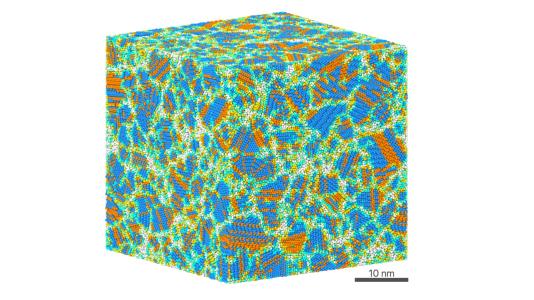
Scientific Achievement
A machine-learning (ML) workflow was developed to introduce a set of coarse grained water models that accurately describes thermodynamics and dynamical transformations of water at the mesoscale. Accurately modeling the phenomena of phase transformations of water, as it moves from ice nucleation at the nanoscopic scale to consolidation into larger grains at the mesoscopic scale, has been a computationally expensive and complex task. Although computational atomistic and coarse-grained models of thermodynamic and transport properties of ice water systems exist, they lack accuracy or computational efficiency or both. Here a machine learning strategy is introduced that can train models on the behavior of ice and liquid water at mesoscopic scales. The set of models are two orders of magnitude cheaper than the most accurate non-polarizable atomistic models of comparable accuracy. These new models adequately describe the thermodynamic and dynamical properties of water and confirm the machine learning (ML) strategy presented here can re-optimize and improve the performance of existing high-quality water models. Proof-of-principle is provided by using the newly developed coarse-grained models (ML BOP and ML-BOPdih) to perform water simulations and elucidate the mesoscale mechanism of ice grain formation and growth from supercooled water.
Significance and Impact
The accuracy of new ML models exceeds existing water models at a computational cost two to six orders of magnitude lower, fulfilling a need for accuracy at modest computational cost. Use of these models may find applications in such areas as phase transitions, homogeneous and heterogeneous nucleation, interfacial properties, co-existent regimes, and mechanical behavior.
Research Details
The ML workflow uses a multilevel evolutionary approach and a training data set derived from the best available atomistic model supplemented by experimental data. This work used the high-performance computing resources of the Carbon Cluster at CNM, ALCF, Fusion at Argonne’s Laboratory Computing Resource Center, and NERSC.
DOI: https://doi.org/10.1038/s41467-018-08222-6
Work was performed in part at the Center for Nanoscale Materials.
About Argonne’s Center for Nanoscale Materials
The Center for Nanoscale Materials is one of the five DOE Nanoscale Science Research Centers, premier national user facilities for interdisciplinary research at the nanoscale supported by the DOE Office of Science. Together the NSRCs comprise a suite of complementary facilities that provide researchers with state-of-the-art capabilities to fabricate, process, characterize and model nanoscale materials, and constitute the largest infrastructure investment of the National Nanotechnology Initiative. The NSRCs are located at DOE’s Argonne, Brookhaven, Lawrence Berkeley, Oak Ridge, Sandia and Los Alamos National Laboratories. For more information about the DOE NSRCs, please visit https://science.osti.gov/User-Facilities/User-Facilities-at-a-Glance.
Argonne National Laboratory seeks solutions to pressing national problems in science and technology. The nation’s first national laboratory, Argonne conducts leading-edge basic and applied scientific research in virtually every scientific discipline. Argonne researchers work closely with researchers from hundreds of companies, universities, and federal, state and municipal agencies to help them solve their specific problems, advance America’s scientific leadership and prepare the nation for a better future. With employees from more than 60 nations, Argonne is managed by UChicago Argonne, LLC for the U.S. Department of Energy’s Office of Science.
The U.S. Department of Energy’s Office of Science is the single largest supporter of basic research in the physical sciences in the United States and is working to address some of the most pressing challenges of our time. For more information, visit https://energy.gov/science.